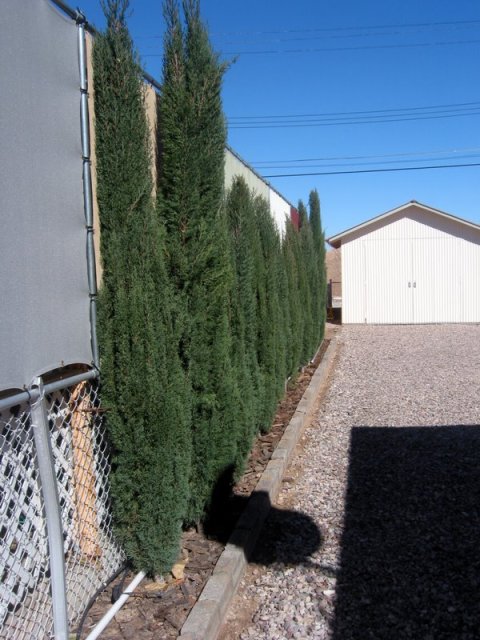Question My Cypress trees
My Cypress trees
QUESTION: Hello, Mr. & Dr. Hyland.
I noted you were away and hope wherever you went or whatever you did was fruitful.
I'm attaching a current picture I made of my row of 15 Mediterrainean Cypress in ground here in Ajo, a small town in the middle of Arizona's Sonoran Desert. The trees have been in ground 3 years this coming March. I have a couple of possibly related issues with the trees which I'd like to obtain your advice on.
The local gardening expert here in Ajo tells us Ajo has fairly decent soil, yet, at the advice of the nurseryman, I did mix in a little of composted mulch, as well as gypsum, as I planted the trees. I later followed more of the nursery advice and added a thick bed of composted mulch under the large bark.
Last summer, I found grubs in the mulch and then some monsoon rains and winds came and caused a number of the trees to lean over. On inspection, I found the soil directly around the base of each tree so loose, I could press my palm down into in 5 or 6 inches. No wonder the trees had leaned. Not knowing what else to do to remedy the situation, I removed the bark and mulch and actually punched my fist down into the soil all around these trees, and then back filled with native soil, and replaced the mulch and bark.
Maybe you heard of those brutal rains in southern CA a couple weeks ago. We got quite a tailspin off those storms here. 5 plus inches of rain, plus near hurricane force gusts. Ajo actually recorded the highest wind gust in the state, at 94. Well, if you had looked closely at the trees in the picture, I have many of them tied at fence level, with plastic tubing. A few of them had blown, not down, but to 45 degree angles. The heavy rain, plus the run off from the neighbors roof--and those winds, where a bad combo for trees all over the place.
So, what is your take on all this? As you can see, the Cypress are in a 2 feet wide bed, contained by a small block stem wall. Shall I get rid of that mulch, and just load that bed full of packed down native soil, and recover with the bark? Could the damp, dark, warmth of that thick mulch environment attracted the grubs? I have heard that grubs can attack roots. Oh, Gawd. We don't need that, especially after what these trees have been through. They need a chance to get going and establish strong roots.
We had been watering automatically, with one (for lack of the right name) "mini sprinkler" per tree, between the trees, which are planted about 30 inches apart.
Can you recommend a compound/ chemical fertilizer or other product to help encourage root growth? What of my idea to remove the mulch and back fill with about 3 inches of compacted native soil?
Thanks so much for reading all of this. These trees are kind of like my children and I would like to see them goo as well as they can, even though this is not the best of climates for them.
Much appreciation for your time and expertise.
Walt
ANSWER: I am afraid you are not going to like my answer.
These trees have a width of spread of about 3-5 feet some may reach 8 feet spread. The root system will extend out about 1 2/3 times the spread meaning the roots extend out about 4 1/2 -7 1/2 feet. The root system is what gives the tree stability and in your case trying to grow them in a 2 foot wide plot of soil the roots cam not spread out far enough to hold the tall tops from being blown over. Also mulch should not exceed about 3 inches deep any deeper will cause the roots to weaken and allow a root rot to enter. But the main problem this tree is too large to grow in the space you have them planted in. Sorry!
---------- FOLLOW-UP ----------
QUESTION: Appreciate you answering so promptly.
I am aware that there are varieties of cypress that do grow as wide as you mentioned--maybe Leyland Cypress? But these are what I've also heard called "Italian Cypress," which have a very compact, narrow growth. They almost look like pencils when mature.
AnswerYes i am talking about Italian Cypress
Mature Height: 40 ft. or trim to desired height
Mature Width: 5 ft.
Sunlight: Full or Partial
Soil Conditions: Very Adaptable
Drought Tolerance: Good
Leyland Cypress
Mature Height: 60-70 ft.
20-30 ft. in rows
Mature Width: 15-20 ft. alone
6 ft. in rows
Sunlight: Full or Partial
Soil Conditions: Adaptable
Drought Tolerance: Good
The width is the total width not just from the trunk and this is at maturity.






